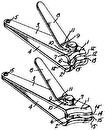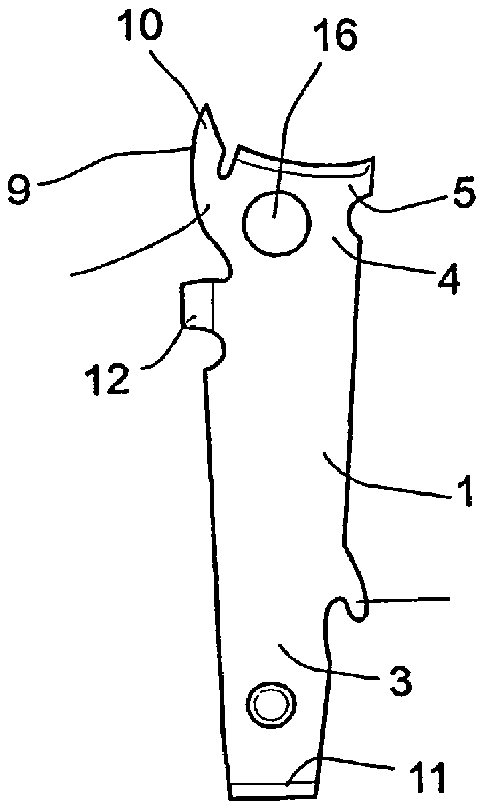
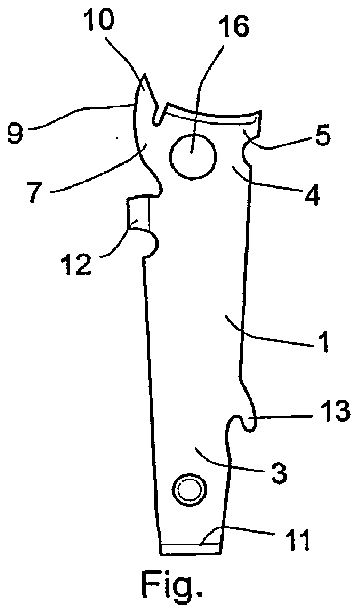
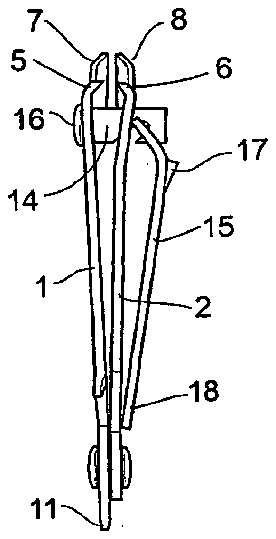
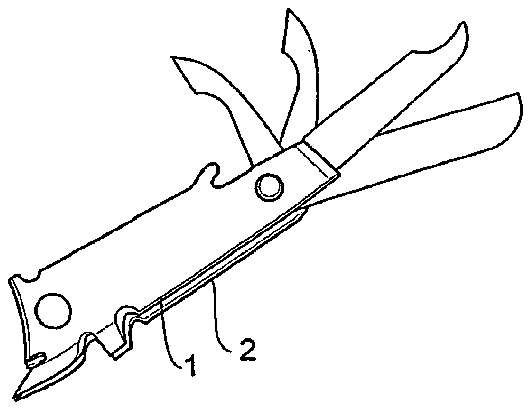
- 2parallel plate
- 3second longitudinal extremity
- 5concave edges
- 7convex edges
- 9attack
- 10culminating vertex
- 12it forms tweezers
- 13bottle opener
- 14shaft
- 15lever
- 17support point
- 18region
- 40ideally approximately
Abstract
Multiple function tool having two plates ( 1, 2 ) substantially parallel and symmetric, each one having a first ( 3 ) and a second ( 4 ) longitudinal extremity as well as being connected at an articulation of the respective first longitudinal extremities, forming a sharp angle between them. The second longitudinal extremities have concave 2 edges ( 5, 6 ) with cutting blades, forming a nail cutter device. The side extremities have convex edges (7, 8) adjacent to the concave edges, having projections sloping in relation to the plane of the plate and with a cooperating cutting blade, forming a cuticle cutter, a cuticle pusher, lifter and a nail cleaner.
Description
[0001] The present invention refers to a tool with multiple functions, including the functions of cutting and cleaning cuticles and fingernails, allowing the users to have at their disposal a series of functions in a single, small-sized device.
DESCRIPTION OF THE STATE OF THE ART
[0002] Innumerable state of the art tools for cutting nails are known, the majority of these generally composed of two parallel plates joined by an articulation at one of its extremities, and, on the opposite end, two concave, symmetrical cutting blades. The blades are placed in such a way that, when one plate is pressed against the other, cutting occurs. However, all of these tools have one basic use, the cutting of nails or the cutting of cuticles, or, moreover, the cleaning of nails. None of the tools already known is suitable to perform all these functions together with the same part of the tool.
[0003] Document PI 9000406 describes a device for cutting nails that also has the function of cutting cuticles. This device comprises an “X” structure with two plates having two ends from which appendages project. One of the appendages has elements for cutting cuticles, and the other appendage has elements for cutting nails. It may be verified that this device has a relatively complex construction in order to allow the cutting of nails and cuticles.
[0004] U.S. Pat. No. 3,261,094 describes a multi-use tool that comprises a set consisting of a pocketknife and a cutter, stored in a case. This tool has two flexible parallel plates connected at a back wall, forming a transversal U-shaped section. Between these parallel plates, blades are provided allowing the performance of various additional functions: such as opening bottles, driving screws etc. Besides these, there are concave, symmetrical blades, forming integral parts of the parallel plates, positioned in such a manner that the plates meet when the flexible parallel plates are pressed together. This tool, however, proves inefficient when the need to cut or remove cuticles, or, even, to clean nails arises, given that the blades of this tool do not have the right shape to perform these functions.
BRIEF DESCRIPTIONS OF THE INVENTION
[0005] The prime objective of the present invention consists of providing a tool with multiple functions, assembled in a device that is easy to hande and small in size.
[0006] Another objective of the present invention is to provide a cuticle cutter adjacent to a nail cutter, in such a way that, between both cutters, an angle of attack is formed that provides several different functions, such as to push and lift cuticles, as well as to clean under fingernails.
[0007] An additional objective of the present invention is to provide a tool with the functions of tweezers, a bottle opener, can opener, and screwdriver.
[0008] The present invention achieves these objectives as a tool with multiple functions, by having two elongated plates, substantially parallel and symmetric, each having a first and a second longitudinal extremity, as well as side extremities. The plates are connected by an articulation at the respective first longitudinal extremity, forming a sharp angle between them. The referred second longitudinal extremity has concave edges with inclined projections in relation to the plane of the plate, forming opposing cutting blades. Each time one plate is pressed against the other, the cutting of nails and cuticles is performed. The side extremities have convex edges with sloping projections in relation to the plane of the plate, forming opposing cutting blades. The concave edges of the longitudinal extremity are adjacent to the convex edge of the side extremity.
[0009] The referred concave edge and convex edge have an adjacent point, forming a vertex with an angle of attack. This angle of attack is used to push and lift cuticles and also to clean fingernails. The referred angle of attack is ideally approximately 40 degrees.
[0010] The-referred tool has, in one of its parallel plates, a first projection integrated with the plate and substantially in the same plane as the plate, this projection bearing an edge that executes the function of a screwdriver.
[0011] The referred parallel plates may also have side extremities with edges featuring projections sloping in relation to the plane of the plate. These sloping projections act, cooperating in such a manner as to form tweezers. One of the referred side edges may also have other projections associated to depressions in order to form a bottle opener.
[0012] The Multiple Function Tool comprises a shaft transversally disposed to the two parallel plates. This shaft has a retention surface at one of its extremities to hold one of the plates, and an articulated lever connected to the other extremity. The referred lever has a support point, which when pressed, causes flexions of both plates up and down. This mechanism may be the same as one used in the already existing state-of-the-art nail cutters.
[0013] Finally, the tool may also have, between the referred parallel plates, a variety of other plates able to perform different functions, such as a nailfile, knife, can opener etc.
BRIEF DESCRIPTION OF THE DRAWINGS
[0014] The present invention will next be described in more detail, based on an example of execution represented in the drawings. The figures show the following:
[0015] [0015]FIG. 1—An enlarged upper view of the multiple function tool, which is the object of the present invention;
[0016] [0016]FIG. 2—An enlarged side view of the multiple function tool, which is the object of the present invention:
[0017] [0017]FIG. 3—An enlarged perspective view of some alternative options for the multiple function tool, which is the object of the present invention.
DETAILED DESCRIPTION OF THE FIGURES
[0018] [0018]FIGS. 1 and 2 show a possible concretization of the multiple function tool of the present invention, consisting of two elongated plates ( 1 , 2 ) substantially parallel and symmetric. Each plate has a first and a second longitudinal extremity ( 3 , 4 ), as well as side extremities. The referred plates are connected by an articulation at the first longitudinal extremity, forming a sharp angle. In this concretization, the connection between the plates is made through a shaft. This connection may, however, also be made through any other means existing in the state of the art, for example, through a screw, a weld, among others, without limiting the scope of the present invention.
[0019] The referred second longitudinal extremity has concave edges ( 5 , 6 ) with sloping projections in relation to the plane of the plate, forming cutting blades for the cutting of nails. This cutting of nails is performed each time that, one plate is pressed against the other plate. By the approximation of one blade with the other blade, the blades perform the cutting.
[0020] The side extremities have convex edges ( 7 , 8 ) adjacent to the concave edges ( 5 , 6 ) of the longitudinal extremity, with sloping projections in relation to the plane of the plate, forming cutting blades for the cutting of cuticles. This cutting of cuticles is performed when the blades are pressed together, by the same principle as the nail cutting blades.
[0021] The referred convex edges ( 7 , 8 ) and the referred concave edges ( 5 , 6 ), have an adjacent point where a vertex is formed, defining the angle of attack ( 9 ). The referred angle of attack ( 9 ) is used to push and lift cuticles, as well as to clean the under part of fingernails.
[0022] It should be noted that, although in the figure shown the angle of attack has its culminating vertex ( 10 ) formed by the outer edges of the referred convex edges ( 7 , 8 ), it is evident to anyone versed in the art that the present invention maintains its functional characteristics with an angle of attack ( 9 ), as much using the projected concave edges ( 5 , 6 ) as the convex edges ( 7 , 8 ).
[0023] One of the referred parallel plates may also include on its first longitudinal extremity a projection in the plane of the plate, forming an edge that defines a screwdriver.
[0024] The referred side extremities may have edges with projections sloping in relation to the plane of the plate, and cooperating in such a way that, when pressing one plate against the other, it forms tweezers ( 12 ).
[0025] One of the referred side extremities may also have edges with projections associated to depressions, substantially in the plane of the plate, which form tools, in particular a bottle opener ( 13 ).
[0026] The edges of the extremities of the multi-function tool may also have other forms, providing new functions, without, however, limiting the scope of the present invention.
[0027] The multiple function tool of the present invention also includes a shaft ( 14 ), disposed transversely in the region close to the second extremity of the plates. This shaft has a retention head ( 16 ) formed at one of the shaft's extremities in order to hold the parallel plate ( 1 ) fixed to it. An articulated lever ( 15 ) is connected at the opposite extremity of this same shaft ( 14 ). This lever is connected to shaft ( 14 ) through a notch in this shaft. The lever ( 15 ) has a bend with support point ( 17 ) exactly at the mid-point of the outer part of the bend, close to shaft ( 14 ). This support point ( 17 ), when region ( 18 ) of the lever is pressed, exerts a force on parallel plate ( 2 ). As this lever ( 15 ) is connected to shaft ( 14 ), the lever, in pressing the support point ( 17 ) forces parallel plate ( 2 ) to move in relation to the length of shaft ( 14 ), also making parallel plate ( 1 ), supported by retention surface ( 16 ) of the shaft, to meet the opposite pressed parallel plate ( 2 ). This mechanism of bringing the plates together may be similar to any one utilized by a nail cutter or nipper in the state of the art.
[0028] In addition, the multiple function tool of the present invention may include other possible concretizations, for example, the ones shown in FIG. 3, where there are plates disposed in parallel between the elongated plates ( 1 , 2 ). There plates are connected at the first extremity through an articulation in a plane parallel to that of the plate. These plates may include, knives, files, can openers or any other tools of appropriate size in order to fill the space between the referred parallel plates.
[0029] Having been described through the examples of preferred concretizations of the present invention, it should be understood, as mentioned above, that the scope of the present invention includes other possible variations, limited only by the content of the claims.

